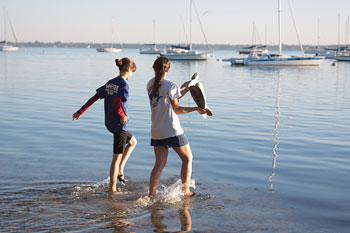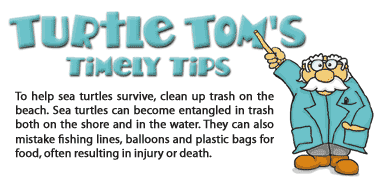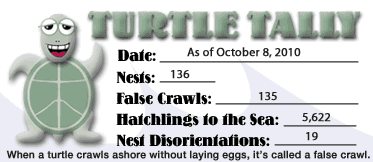Sea turtles have good season
From the October 13, 2010 Issue
PHOTO PROVIDED BY MOTE MARINE LABORATORY
Hayley, a green sea turtle, is released into Sarasota Bay by
Mote public relations specialist Hayley Rutger, left, for whom
the turtle is named, and Mote intern Kassie Movsesian. The
turtle stranded in the bay in February and was rehabilitated
at Mote for cold stress and tumors called fibropapillomas. She
is the last cold-stunned patient to be released this year from Mote.
Sea turtles have laid more nests on Florida’s beaches this year than the 10-year statewide average, and Anna Maria Island’s turtle activity is right on target.
This year, loggerhead turtles laid 134 nests on the Island, exactly on track with the 10-year average of 134, according to Anna Maria Island Turtle Watch and Shore Bird Monitoring statistics.
The number is down from 161 last year, which was an unusually good year, Turtle Watch Director Suzi Fox said.
Statewide, nesting is above the 10-year average for all three species of sea turtles that nest on Florida beaches – loggerheads, leatherback and green – according to the Florida Fish and Wildlife Conservation Commission (FWC).
Loggerheads, the main species that nests on the Island, have experienced nesting declines in recent years, but had 30 percent more nests this year statewide than the 10-year average.
Statewide nesting numbers for leatherback and green sea turtles also increased, with the second-highest number of nests since standardized counts began in 1989.
“We’re encouraged by the high count, especially considering the oil spill and the extreme cold weather earlier in the year,” said Dr. Blair Witherington, an FWC Fish and Wildlife Research Institute scientist. “However, one good year can’t reverse a declining trend.”
Because of the downward trend, the National Oceanic and Atmospheric Administration’s (NOAA) National Marine Fisheries Service is considering classifying nine loggerhead populations as separate species under the federal Endangered Species Act, with two as endangered and seven as threatened.
On the Island, loggerheads laid more nests on the bay side than they did last year – 11 in all – and Turtle Watch volunteers have begun informally monitoring the bay side and educating bayfront residents about the necessity of not allowing indoor or outdoor lights to disorient and kill hatchlings, Fox said.
A grant from the National Fish and Wildlife Foundation’s Recovered Oil Fund for Wildlife, made possible with proceeds from BP’s share of net revenue from oil recovered from the Deepwater Horizon site, recently enabled Turtle Watch to offer free turtle-friendly lighting to several waterfront property owners who had been in violation of Island lighting ordinances, she said.
Nineteen nests have been disoriented by lights on the Island so far this year, a loss of 1,565 hatchlings.
While nesting season began on May 1, the first nest was not laid until May 22, significantly later than last year’s first nest on May 8, which Fox attributed to an unusually long, cold winter that affected the turtles’ food source, delaying their arrival.
The Island’s first nest this year hatched 69 turtles on July 27. Eight turtle nests remain unhatched. Turtle season ends on Oct. 31.



